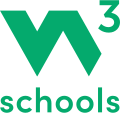 | |
Type of site | Web development portal |
|---|---|
| Available in | Multiple languages |
| Owner | Refsnes Data AS |
| Created by | Refsnes Data AS |
| URL | www |
| Commercial | Yes |
| Registration | Required for forum |
| Launched | 1998 |
| Current status | Active |
W3Schools is a freemium educational website for learning coding online. [1] [2] Initially released in 1998, it derives its name from the World Wide Web but is not affiliated with the W3 Consortium. [3] [4] [ unreliable source ] W3Schools offers courses covering many aspects of web development. [5] W3Schools also publishes free HTML templates. It is run by Refsnes Data in Norway. [6] It has an online text editor called TryIt Editor, and readers can edit examples and run the code in a test environment. The website also offers free hosting for small static websites.